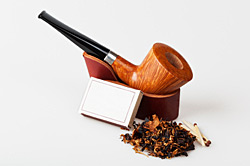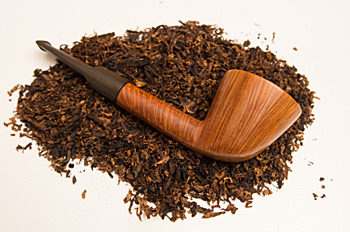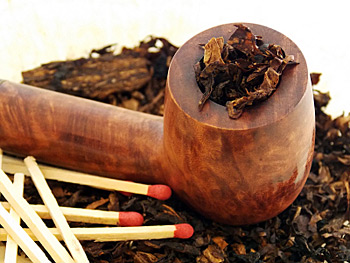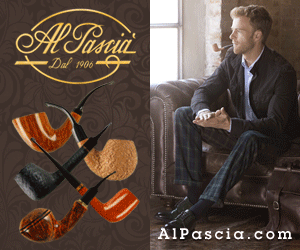Russ Ouellette
 Is there more art or science to the pipe smoking pastime? At least from one perspective, I’m sure that it’s leaning towards art. In my mind, one of the best ways to delineate between the two is the terminology. A chemical compound, for example, isn’t open to interpretation. To borrow an overused and somewhat fatalistic modern phrase- it is what it is. But art, as a category, is awash in blurred lines; one man’s jazz is another man’s rock. Two different restaurants may serve a similar, or even identical dish, but categorize them differently. Styles of painting can sometimes fall between two disparate schools. Of the industries I’ve been involved in, pipe smoking terms are open to interpretation more than in any of the rest.
Is there more art or science to the pipe smoking pastime? At least from one perspective, I’m sure that it’s leaning towards art. In my mind, one of the best ways to delineate between the two is the terminology. A chemical compound, for example, isn’t open to interpretation. To borrow an overused and somewhat fatalistic modern phrase- it is what it is. But art, as a category, is awash in blurred lines; one man’s jazz is another man’s rock. Two different restaurants may serve a similar, or even identical dish, but categorize them differently. Styles of painting can sometimes fall between two disparate schools. Of the industries I’ve been involved in, pipe smoking terms are open to interpretation more than in any of the rest.
We just re-launched our website, and on the new format, we had to put characteristics for all the pipes into a tool, so the information would be visible to our customers, and at times it was a struggle. At what point does a billiard become an egg? Is a tall pot still a pot, or does it become a billiard? If a Zulu is flared more at the top of the bowl, is it now a bent Dublin? In the couple of months we spent putting all of these characteristics into our system, we had more than a few disagreements on shapes. In a handful of cases, the manufacturer’s description referred to a pipe as one shape, while we considered it something else. In that case, what should we do?
One of the most difficult categories was freehands. Some people consider a freehand to be a shape. I don’t, but some makers put freehand in the description, so who’s right? The majority of the pipes that use that descriptor are, in my mind, a stylized Dublin, but to simplify things, we accepted freehand as a shape.
Is the stain walnut, pecan, or is it brown? One company calls a stain cherry, and the next will refer to it as mahogany. Some pipes, when sandblasted, look more like a rusticated pipe, especially when a piece of briar with open grain is blasted.
When we venture into tobaccos, it’s as bad, or worse. I view Orientals as a broad category, with Turkish being a subset. Some companies use the terms interchangeably. What confuses the issue further is that the individual varietals used to be available under their own names- Yenidje, Xanthi, Bashi Bagli, Mahalla, etc. Now, much of what’s accessible are blends of different strains, and the lines become even less distinct. To make matters worse, if I’m using a blend, I have to rely upon the supplier’s description. If they say that a blend of Orientals contains Dubec, I can’t dispute it, as it would be nearly impossible to disprove. The companies I buy from are reputable, so I’m not too concerned, but if they wanted to make a substitution, it would be hard to know, unless they told me.
 Categories of blends are another area of confusion. In the recent past, the term “English” has meant a Latakia-based blend with Virginias as the secondary note, while “Balkan” referred to a Latakia blend with Orientals-forward. When I first started in the business, in the seventies, English generally referred to tobaccos without a noticeable top-dressing, because, back then, British manufacturers were extremely limited, by law, in the additives they could use.
Categories of blends are another area of confusion. In the recent past, the term “English” has meant a Latakia-based blend with Virginias as the secondary note, while “Balkan” referred to a Latakia blend with Orientals-forward. When I first started in the business, in the seventies, English generally referred to tobaccos without a noticeable top-dressing, because, back then, British manufacturers were extremely limited, by law, in the additives they could use.
Greg Pease was the first person, as far as I know, who publicly suggested that we ditch those inaccurate labels, and I’ve tried to avoid them since I read his opinion, because I agree. “Latakia blend, Virginias-forward” is a much more precise terminology, but it’s also more unwieldy so the old nomenclature persists. To break all blends down into “English”, “Non-Aromatic” and “Aromatic” is painting with an awfully broad brush, yet we decided to use those categories on our website, because they were the most commonly used.
The problem for the consumer is that these labels create issues when looking at new blends. A Prince Albert devotee may be somewhat reluctant to try a new blend based upon it being categorized as “non-aromatic”, because, by experience, (s)he may have found that the grouping may also include Virginia/Perique mixtures. But if that person saw that a tobacco was described as a “semi-aromatic, Burley-based” blend, it might be worth a shot.
This confusion is part of the reason that, long ago, we made the decision to include the components in the description of our blends. It’s not as if listing the individual tobaccos will give people the key to recreating it themselves. There are so many factors, aside from components and proportions, that can change a blend, that it would be nearly impossible to reconstruct one from a list of what it contains. Besides, it would probably be more expensive to make on your own. That’s why we have been up-front about what leaf we use.
 If we move away from those broad descriptions, how many different labels should we use? I figured that it would take about fifteen distinct divisions to cover everything, but as I soon as I finished my list, I could find examples that didn’t seem to fit any of them. It got to a point where it would almost be easier just to list the components.
If we move away from those broad descriptions, how many different labels should we use? I figured that it would take about fifteen distinct divisions to cover everything, but as I soon as I finished my list, I could find examples that didn’t seem to fit any of them. It got to a point where it would almost be easier just to list the components.
After giving this more thought than it probably deserves, I came to the conclusion that it would be very difficult to refine these labels. Firstly, it would be almost impossible to get a consensus on new descriptions. Secondly, we’d have to overcome the intransigence of some people to accept the changes.
Finally, I realized that it might be best to leave well enough alone. I’m all for disclosure and transparency, and I appreciate accuracy, so why would I be okay with the status quo? I’ve had some fun and spirited discussions about pipe shapes and blend types, so a change would, possibly, eliminate a lot of them. Although I would still prefer clarity, I also enjoy the occasional friendly argument.
|
Russ Ouellette is the blender/creator of the Hearth & Home series of tobaccos for Habana Premium Cigar Shoppe and www.pipesandcigars.com in Bethlehem, PA. He has been a pipe smoker and blender for over 30 years, and enjoys feedback from the pipe smoking public. You can reach Russ at russo@pipesandcigars.com or by calling 1-800-494-9144 on Monday, Wednesday and Thursday from 9 am to 5 pm and Friday from 1 pm to 5 pm. |




















I can’t tell you how many friendly arguments I’ve had over the ingredient “Oriental”. I just usually say, “Well, let me try a bowl!” Your insight is always an education Russ, Thanks!
It is by all means “How You Look at It”. I can have a fellow pipe smoker tell me he doesn’t like English blends, but when I give him a bowl of a “typical” English blend, he enjoys it. It surprises the heck out of him what the blend is. As far as shapes of pipes, it is all art. But it cannot be truly appreciated until one can actually hold and inspect it. I, for one, need to hold a pipe in my hand to see how it feels. No two pipes are the same, even of the same manufacturer, model and style. This is why I dislike to buy from the internet(unfortunately, due to lack of Pipe shops in Miami). I do appreciate the craft of Pipe makers and tobacco blenders. Thank you Russ for your articles and insights
Loved reading your article! It was very funny also! To categorize points of view!! Freehand or not so much!? Egg or billiard!! LOL. About tobaccos I like the straight forward descriptions. Your definition of English versus Balkan is now my reference about these two styles of tobacco blends. Thanks for the great insights on such an art form: pipes and tobaccos.
I personally like Amphora and Balkan.I tried Erinmore..its very good but so strong..
Thanks for a well written article. I’m glad to read that blenders are sensitive to the issue of informative tin descriptions. Those that I appreciate the most are simple lists of ingredients and amendments without poetical embellishment or promotional hype.
A very provacative article to be sure and I really get what you are saying when it comes to orientals. I too hold judgement on any blends capacity to “deliver the goods” when it comes to pure enjoyment and I don’t have a refined enough pallate to distinguish any given type of “oriental leaf”. I rely on the smoking experience over time and the rotation of briar or cobs to give a more accurate evaluation as to whether the blend is a keeper. I personally tend to gravitate towards Balkan and prefer the complexity experienced throughout the bowl. Thanks for a superb article!